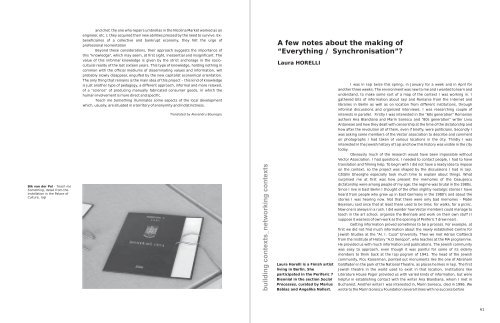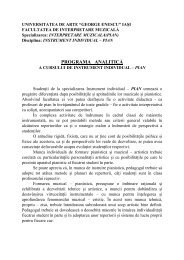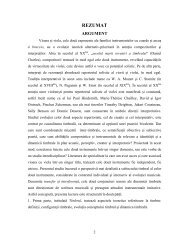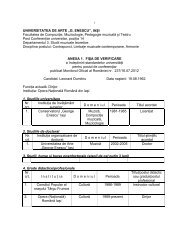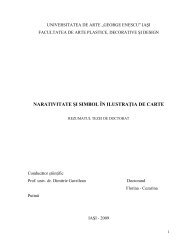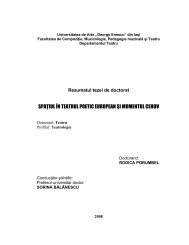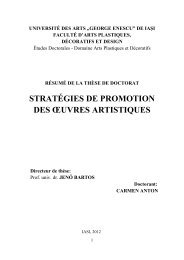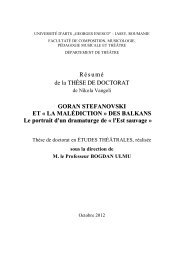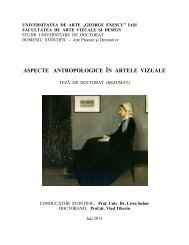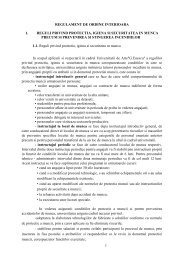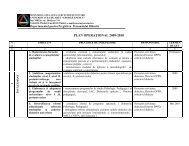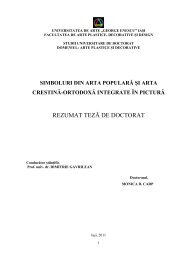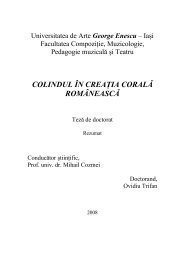vector 2_1.cdr - Universitatea de Arte "George Enescu"
vector 2_1.cdr - Universitatea de Arte "George Enescu"
vector 2_1.cdr - Universitatea de Arte "George Enescu"
Create successful ePaper yourself
Turn your PDF publications into a flip-book with our unique Google optimized e-Paper software.
Bik van <strong>de</strong>r Pol - Teach me<br />
Something, <strong>de</strong>tail from the<br />
installation in the Palace of<br />
Culture, Iaşi<br />
and chef, the one who repairs umbrellas in the Nicolina Market worked as an<br />
engineer, etc.); they acquired their new abilities pressed by the need to survive. Exbeneficiaries<br />
of a collective and bankrupt economy, they felt the urge of<br />
professional reorientation<br />
Beyond these consi<strong>de</strong>rations, their approach suggests the importance of<br />
this “knowledge”, which may seem, at first sight, inessential and insignificant. The<br />
value of this informal knowledge is given by the strict anchorage in the sociocultural<br />
reality of the last sixteen years. This type of knowledge, holding nothing in<br />
common with the official mediums of disseminating values and information, will<br />
probably slowly disappear, engulfed by the new capitalist economical orientation.<br />
The only thing that remains is the main i<strong>de</strong>a of this project – this kind of knowledge<br />
is just another type of pedagogy, a different approach, informal and more relaxed,<br />
of a “science” of producing manually fabricated consumer goods, in which the<br />
human involvement is more direct and specific.<br />
Teach me Something illuminates some aspects of the local <strong>de</strong>velopment<br />
which, usually, are situated in a territory of anonymity and indistinctness.<br />
Translated by Alexandru Bounegru<br />
building contexts_networking contexts<br />
A few notes about the making of<br />
“Everything / Synchronisation”?<br />
Laura HORELLI<br />
Laura Horelli is a Finish artist<br />
living in Berlin. She<br />
participated in the Periferic 7<br />
Biennial in the section Social<br />
Processes, curated by Marius<br />
Babias and Angelika Nollert.<br />
I was in Iaşi twice this spring; in January for a week and in April for<br />
another three weeks. The environment was new to me and I wanted to learn and<br />
un<strong>de</strong>rstand, to make some sort of a map of the context I was working in. I<br />
gathered bits of information about Iaşi and Romania from the Internet and<br />
libraries in Berlin as well as on location from different institutions, through<br />
informal discussions and organized interviews. I was researching couple of<br />
interests in parallel. Firstly I was interested in the “60s generation” Romanian<br />
authors Ana Blandiana and Marin Sorescu and “80s generation” writer Liviu<br />
Antonesei and how they <strong>de</strong>alt with censorship at the time of the dictatorship and<br />
how after the revolution all of them, even if briefly, were politicians. Secondly I<br />
was asking some members of the Vector association to <strong>de</strong>scribe and comment<br />
on photographs I had taken of various locations in the city. Thirdly I was<br />
interested in the Jewish history of Iaşi and how this history was visible in the city<br />
today.<br />
Obviously much of the research would have been impossible without<br />
Vector Association. I had questions, I nee<strong>de</strong>d to contact people, I had to have<br />
translation and filming help. To begin with I did not have a ready i<strong>de</strong>a to impose<br />
on the context, so the project was shaped by the discussions I had in Iaşi.<br />
Cătălin Gheorghe especially took much time to explain about things. What<br />
surprised me at first was how present the memories of the Ceauşescu<br />
dictatorship were among people of my age; the regime was brutal in the 1980s.<br />
Since I live in East Berlin I thought of the often slightly nostalgic stories I have<br />
heard from people who grew up in East Germany in the 1980's and about the<br />
stories I was hearing now. Not that there were only bad memories - Matei<br />
Bejenaru said once that at least there used to be time; for walks, for a picnic.<br />
Now one is always in a rush. I did won<strong>de</strong>r how Vector members could manage to<br />
teach in the art school, organize the Biennale and work on their own stuff (I<br />
suppose it was less of own work as the opening of Periferic 7 drew near).<br />
Getting information proved sometimes to be a process. For example, at<br />
first we did not find much information about the newly established Centre for<br />
Jewish Studies at the "Al. I. Cuza" University. Then we met Adrian Cioflâncă<br />
from the Institute of History “A.D Xenopol”, who teaches at the MA programme.<br />
He provi<strong>de</strong>d us with much information and publications. The Jewish community<br />
was easy to approach, even though it was painful for some of its el<strong>de</strong>rly<br />
members to think back at the Iaşi pogrom of 1941. The head of the Jewish<br />
community, Picu Kaiserman, pointed out monuments like the one of Abraham<br />
Goldfa<strong>de</strong>n in the park of the National Theatre, as places he likes in Iaşi. The first<br />
Jewish theatre in the world used to exist in that location. Institutions like<br />
Literature House Pogor provi<strong>de</strong>d us with varied kinds of information, but were<br />
helpful in establishing contact with the writer Ana Blandiana, whom I met in<br />
Bucharest. Another writer I was interested in, Marin Sorescu, died in 1996. We<br />
wrote to the Marin Sorescu Foundation several times with no success before<br />
61


